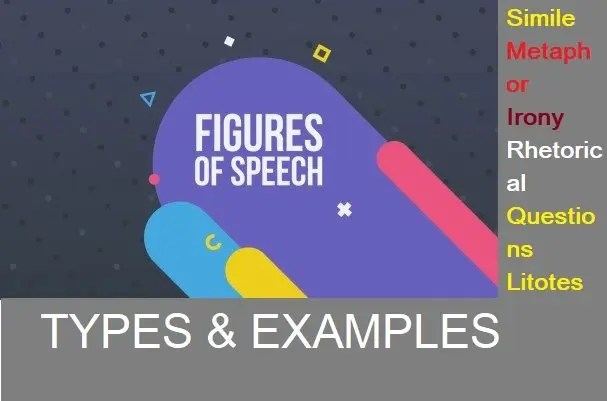
What is Figures of Speech?
Figures of speech are words used in a very special way quite different from the ordinary. They are words used figuratively. You’re different from part of speech. there are numerous examples of figures of speech but closer attention is going to be paid to those particular figures of speech commonly met in your examinations.
Types of Figures of Speech
1. Simile
It is a direct comparison of two things that are basically different in nature but a similar in one aspect of the other using the word ‘like’ or ‘as’. For example, simile is used in this sentence. ‘Car owners worried by the possibility of being reduced to using public transport, now nurse their old cars as mothers nurse their babies. (WASSCE Nov. 1996)
2. Metaphor
This is the commonest figure of speech. Metaphor is a compressed or implied simile; a direct comparison between to essentially different things without using the words ‘like’ or ‘as’ beautiful as used in the underlined portion of the following sentences:
(a) … so that the housewife finds herself tired and irritable even though the house work has been done by her mechanical slaves.
(b) … the financier who sits back at home while they let loose the dogs of vandalism and death
(c) I sat down and waited for the storm to break.
The above three sentences examples of metaphor.
3. Personification
This is giving human attributes or qualities to an inanimate object or a non-living object as though it were a living one. the person inside a thing is to make button look like or behave like a person. For example: the expression, while his pen is dancing furiously on the paper is personification because ‘pen’ which is inanimate object is given the human attributes of dancing.
4. Hyperbole
This is a deliberate exaggeration made for emphasis. It is at times called and overstatement. For example, hyperbole is used in this expression: “He thanked me a dozen times for what I had done for him”. ‘Thousand’ must be an exaggeration or an overstatement and it is used here to emphasize how thankful the person was. Other examples are …
a. Labour myself to death
b. I would never leave my wife in a million years.
c. I’ll cross the ocean just to see you
d. I will drink the ocean just to quench my thirst..
5. Euphemism
Euphemism is placing an unpleasant facts in a more pleasant way. It involves the use of mild expression to avoid the direct expression that will convey an unpleasant truth. For example, euphemism is used in this expression: “the man passed away last night” in the real sense, this simply means the man had died but it was expressed in a mild and less serious manner.
6. Irony
Irony is speaking the opposite of what we need or have a mind in other words, opposite meaning is intended in irony. The irony will be so expressed that anybody will read it will know that you mean the opposite. For example, irony is implied in statements like these: “the best way to avoid death is by jumping into fire” or “our school team has a good soccer record the team has won 18 of their last 15 matches”
7. Paradox
It is a statement that seems or actually does contradict itself but when examined closely it has some hidden truth and wisdom. For example statements like i”f a man would save his life he must lose it” and “more haste less speed” are paradoxical. Other examples of ‘four is foul, foul is fair and their great strength is also their weakness’
8. Oxymoron
It is replacing together side by side of two words that contradict each other. Examples of oxymoron are “little Giants bittersweet necessary evil and open secrets’
9. Rhetorical Questions
It is a question asked but which requires no answer or which is not meant to be answered. the answer is not necessary because it is usually employed or indirectly suggested in a question. It is often used to seek for information in a speech.
Examples of rhetorical questions are:
a) Can’t you see that the boys are more useful than the girls?
b) Who can prevent the sun from rising.
10. Litotes
It is an understatement. It is the opposite of hyperbole or exaggeration. Example of sentence it is no laughing matter, is a litotes which point out that the matter is not a matter meant for laughter. It further reiterates the seriousness of the matter at hand. This indicates that this is a serious matter other sentences where Litotes is used are:
a) he achieved know little success.
b) It is no easy matter.
c) The girl is no idiot to smile while being insulted.
This topic in English is a very vital area where students are tested every academic session in WAEC, NECO or JAMB. It is important you know what figures of speech is about, being able to identify the types of figures of speech as well as attempt successfully, any question bothered around figures of speech in any examination or test based on the various examples cited in this post.
